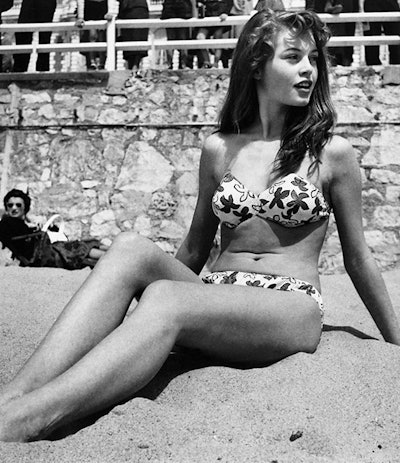
Few things say aquatic fun more clearly than the two-piece woman's swimwear garment known as the bikini. Once considered scandalous (or even obscene to some), for the past seven decades, the bikini has nonetheless become a fixture in women's fashion and beachwear.
Although estimates vary, since 2000, worldwide bikini sales have hovered around $1 billion.
Some fashion historians and even more scholarly sociologists point to the rise of the bikini as a harbinger of feminism in the '50s and '60s, while others decry it as an emblem of female objectification and moral decay. For most consumers the bikini is less about social change and far more simply a familiar, even iconic representation of all things summer and fun. Whether viewed as an revolutionary fashion statement or a disgraceful public spectacle, or something between, there is no doubt the bikini has had a profound impact on the way women dress for swimming and sunbathing.
Precursors to the bikini reach back to early antiquity, with the first images of shapely women donning two-piece apparel appearing in European civilization as far back as 5,600 B.C. Images of Roman goddesses wearing bikini-like garments appear in the late third century B.C. with some of the most famous images found in the ruins of Pompeii, where mosaics and frescos of Venus wearing revealing two-piece outfits were unearthed.
In the modern era, the evolution toward the bikini began in earnest in 1913 when swimwear designer Carl Jentzen designed the first two-piece bathing suits for women's swimming competitions, which were introduced to the world a year earlier in the 1912 Olympics.
Credit for creating the first bikinis as they're known today goes to two French designers who introduced separate versions within a few days of each other in the summer of 1946.
Designer Jacques Heim introduced the "Atome" followed immediately on July 5 by a similar design from Louis Reard, who named his suit the "Bikini." The name is a reference to the infamous atomic bomb test on the South Pacific atoll bearing the same name on July 1, just four days earlier. Because attractive women were commonly referred to as "bombshells," both designers used atomic bomb references in naming the suits. Obviously, the word "bikini" would become forever synonymous with the style while Heim's Atome would fade into obscurity.
The design was so controversial that Reard couldn't convince top fashion models to don the bikini for its debut. Instead he turned to burlesque dancer Micheline Bernadini who became the first woman photographed wearing the newly minted bathing suit.
In 1953, Brigitte Bardot became the first celebrity associated with the bikini when she famously posed in one for a photo shoot at the Cannes Film Festival. After that, the suit began appearing with the increasing frequency on the beaches of the French Riviera and other exotic locals.
Evidence of the bikini's impact was at first most evident in the blistering criticism it received during the '50s. In 1957, for example, an editorial Modern Girl Magazine opined, "It is hardly necessary to waste words over the so-called bikini, since it is inconceivable that any girl with tact and decency would ever wear such a thing."
Around the same time, fashion designer Anne Cole was famously quoted saying the bikini was the "razor's edge of decency."
Despite the controversy — and arguably partly because of it — the bikini would soon explode across American pop culture. In 1960, recording artist Brian Hyland scored a monster novelty hit with "Itsy Bitsy Teenie Weenie Yellow Polka Dot Bikini," which famously told the story of the girl who "wouldn't come out of the water." Shortly thereafter, Annette Funicello took the bikini mainstream with the camp classic movie, "How to Stuff a Wild Bikini." In 1962, Ursula Andress further stoked interest and mystique when she sensuously walked out of the surf in the James Bond classic "Dr. No," thus giving rise to the "Bond Girl."
As the social upheaval and cultural revolution of the '60s began to take shape, the bikini came along for the ride. Sports Illustrated introduced the Swimsuit Issue in 1964, featuring a bikini-clad model on the cover. In 1966, Raquel Welch turned up the heat several notches with her animal skin bikini in "One Million Years B.C."
In the early '70s, the bikini experienced another surge in both popularity and controversy when supermodel Cheryl Tiegs dawned the "micro" or "string bikini." By then the sexual revolution was in full swing and bikinis kept pace with ever-shrinking styles. In 1988, the G-string bikini reignited swimwear controversy with its nearly nude design. Critics not only found the G-String distasteful, but also unflattering to all but a very small percentage of women.
Around the same time, however, designers began reintroducing more modest designs that would eventually become known as tankinis, essentially two-piece bathing suits that featured tank tops and more modest bottoms.
In 1996, when beach volleyball made its Olympic debut, elite women players such as Gabriella Reese reclaimed the bikini as athletic wear with designs that, although still abbreviated, also featured tops and bottoms designed for the support and the modesty required for high-profile competition.
Today, the bikini is a familiar garment for women young and old, models, actresses, athletes and even superheroes. In celebration of the bikini's 1946 debut, July 5 has been designated National Bikini Day.












































